
|
 |
Douglas A-20 Havoc |
 |
 |
 |
 |
 |
|---|---|---|---|---|---|---|---|
 |
 |
 |
 |
 |
|||
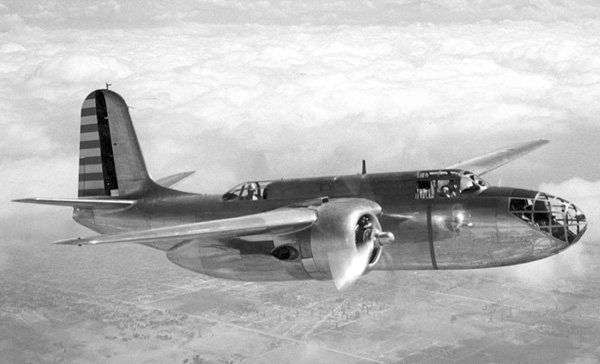 |
||
|
The Douglas A-20 Havoc was a light-bomber, attack and night-fighter and one of the first American aircraft to serve in World War II. First built during the late-1930s, the majority of Havocs served with the Soviets, with the next biggest operator being the US Army Air Force (USAAF), followed by Great Britain. Other operators included Canada, France, Australia, South Africa, and the Netherlands. It also served in the postwar years with Brazil until the 1950s.1
It was also known as the DB-7 (Douglas Bomber 7) and as the Boston or Ranger to the British. It was said to be easy to fly with good handling characteristics during takeoff and landing. It represented an advance in flight control systems with light handling during high-speed flight, with no overbalance on small control inputs. The tricycle landing gear made takeoff, landing and ground handling very simple and pilots were able to fly it with a minimum of instructions. It also provided a stable gun platform for night-fighter missions. Handling with one engine out was also said to be very satisfactory, although the prototype crashed while simulating an engine-out procedure.2 It was very durable and was able to withstand extreme battle damage and found a role in every combat theater of the war. It was a "pilot's airplane".
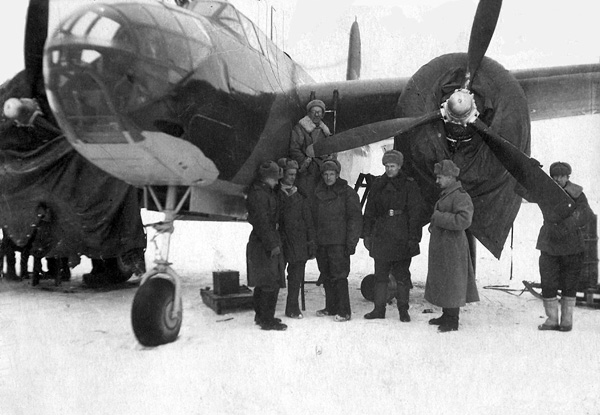 The Soviets were the largest operator of the Havoc. Design work began in 1936 by Donald Douglas, Jack Northrop and Ed Heinemann as the Model 7A attack-bomber with a crew of two, a top speed of 250 mph, and a gross weight of 9,500 lbs. It was powered by two 450 hp Pratt & Whitney R-985 Wasp Junior engines, but conditions were changing rapidly in 1937, due to events in the Chinese and Spanish wars. Looking to replace their Curtiss A-12s and Northrop A-17s, the US Army Air Corps (USAAC) issued the following requirements:3
• 1,200 mile range. |
| The 7A would have been obsolete upon delivery and it was revised. The new design would have a three man crew and power was increased with two 1,100 hp Pratt & Whitney R-1830C Twin Wasp engines. The observer’s compartment was eliminated and the bomb bay enlarged. The fuselage was narrowed and permitted no physical contact between the crew members. The aircraft was unique in that it could be built with two different nose configurations as an attack or bomber version. The attack version had a solid nose designed to carry six 0.30 caliber machine guns with two 0.50 caliber machine guns in the nose. The bomber version nose was glazed and allowed space for a bombardier and bomb site which replaced the machine guns. The new design was given the Douglas designation Model 7B.4 |
|
The new design was submitted to the USAAC for a competition to compete against the Bell Model 9, the Stearman X-100, Martin Model 167F and the North American NA-40. All designs were promising and all were asked to build prototypes for evaluation. Bell was the only company that declined. The Douglas prototype made its inaugural flight on October 26, 1938 and proved to be a success from the start. (The Martin 167 would develop into the Martin Maryland and the North American NA-40 would develop into the (NA-62) B-25 Mitchell.)
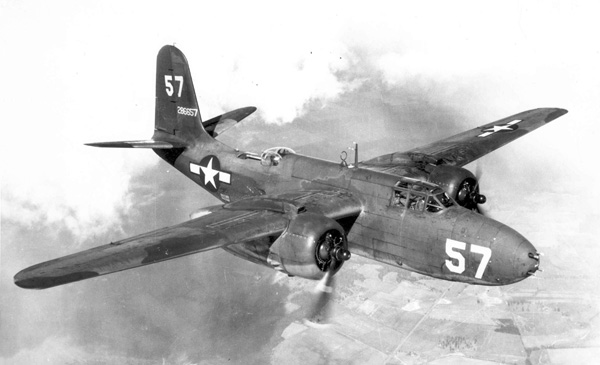
The first recipient for the Havoc was the French government who ordered 100 DB-7s on February 15, 1939. The order proceeded despite an accident when a French observer was aboard and the DB-7B prototype crashed during an engine-out procedure on January 23, 1939. When the American press discovered there was a French citizen on board, a major protest ensued from American isolationists (the US Government was also trying to appear neutral to Germany), but the order was allowed to continue despite the controversy. The French order was followed by a USAAC order on August 17, 1939. After World War II started, the French ordered additional aircraft for a total of 270 aircraft, and the British ordered 150 DB-7Bs on April 17, 1940. The British order was later increased to 300 on May 10th. After the collapse of France on July 26th, 200 French aircraft were diverted to England. These aircraft were designated by the British as Boston Is.5
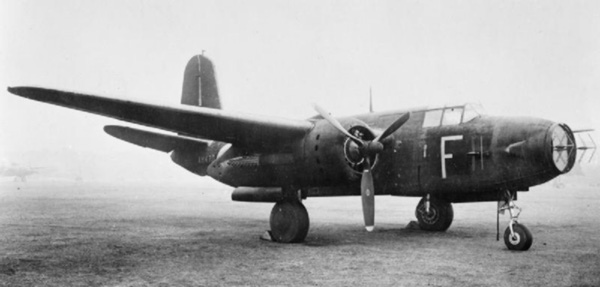 A Boston I equipped with a 2,700 million candlepower Turbinlite. There were several variants of the Havoc. The Boston I was powered by two Pratt & Whitney R-1830 engines and was completely equipped to French specifications. All instruments were metric and the radios were not compatible with the British system and it could not accommodate British bombs. The throttle system also operated in the opposite direction of the British and American system and had to be reconfigured. Its high speed was its only asset and it was equipped as a night fighter with eight 0.30 caliber machines guns mounted in the nose. They were assigned to the No. 23 Squadron and a number of aircraft were equipped as Turbinlite squadrons with a 2,700 million candlepower searchlight in the nose. The Turbinlite was not a success as it gave away the position of the aircraft and it was replaced with Aircraft Interceptor (AI) radar equipped Beaufighter and Mosquito night fighters in early 1943. Havoc IIs were French DB-7As converted to night fighters. A solid nose housed twelve 0.303 caliber machine guns and was fitted with AI radar. Thirty-nine Havoc IIs were fitted with the Turbinlite, but without armament. All DB-7 versions were known to the British as the Boston. The British later converted their Bostons to radar equipped night-fighters and theses were collectively known as Havoc Is. The USAAF referred to the plane as the A-20 Havoc, and the reconnaissance version as the F-3. After the United States entered the war, plans were made to produce an aircraft specifically as a night-fighter. The Northrop P-61 would eventually fulfill this role, but until then, something else was needed to fill the gap. The Americans followed the British lead and designated the night-fighter version of the Havoc as the P-70, making it perhaps the only bomber to converted to a fighter.6 The P-70 was equipped with the British AI Mk.IV radar and four 20 mm canons mounted in a “bathtub” located in the bomb bay. Training was conducted in Orlando, Florida and crews used to perform mock low-altitude attacks on nearby Panama City and drop dummy bombs on trains. The next morning, train crews would be puzzled to find fluorescent dye splattered atop the cars.7 The Boston III (DB-7B) was the first batch to be ordered directly for the RAF. It was a pleasant surprise to the British crews who had been operating Bristol Blenheims.8 It was twice as powerful and carried twice the load and was a very strong reliable aircraft—it was also 80 mph faster. If an engine was lost on takeoff, control was considered outstanding with one-engine performance, unlike the Lockheed P-38 Lightning and Martin B-26 Marauder which took much experience to maintain control on one engine.
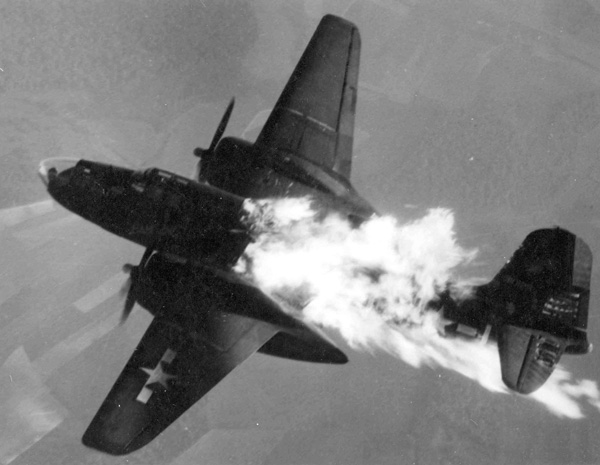 An American A-20 Havoc bursts into flames after taking a direct hit from flak. The A-20A was the first major production version for the USAAC. They were powered by 1,600 hp Wright R-2600-11 engines and were not turbocharged. Turbochargers were not included because of cooling difficulties and since the Havoc was intended to perform low and medium altitude missions, turbocharging was not required. Weight was increased 3,750 lbs (1,700 kg), self-sealing fuel tanks were installed and fuel capacity was 394 US gallons (1,500 liters). The planned armament consisted of four 0.30 caliber machine guns in side-mounted fuselage blisters instead of in the nose, twin 30s in an open dorsal position, and one 0.30 in the ventral position. Provisions were made to mount aft-firing 30s in the engine nacelles triggered by a foot pedal by the pilot, but these were rarely installed.9 The A-20B was powered the same as the A model and had a modified Plexiglas nose. Bombs racks were changed from a vertical to horizontal configuration and the bomb bay could house a 200 gallon (750 liters) fuel tank for ferrying purposes. Two 0.50 caliber machine guns were mounted in the forward fuselage, one 0.50 was placed in the open dorsal position and one 0.30 was mounted in the ventral position. A field modification replaced the plastic nose with a solid nose, which housed four to six 0.50 caliber machine guns. 999 A-20Bs were built at the Douglas plant in Long Beach, California. Six A-20Bs were transferred to the US Navy and designated BD-2s. The A-20G variant was built in greater numbers than any other version. It had a solid nose, which housed a battery of guns. They were powered by two Wright R-2600 engines and a total of 2,850 aircraft were built at Santa Monica. Other changes were the addition of carburetor heat, heavier armor plating, and removal of the dual controls in the gunner’s compartment. The A-20G-1 nose contained four 20-mm cannons, one 0.50 caliber machine gun in the dorsal position, one 0.30 caliber machine gun in the ventral position and 2,000 lbs of bombs internally. The A-20G-5 replaced the nose cannons with six 0.50 caliber machine guns, but were found to be less accurate. Starting with the 751st aircraft in the series, the A-20G-20 replaced the dorsal machine gun with a Martin turret with twin 0.50 machine guns and twin 0.50s were placed in the ventral position. Bomb racks were also added to carry 500 lbs of bombs beneath the outer wing panels. Visibility for the Havoc was good from the cockpit and stall characteristics were considered docile and it handled very well during low flying operations. During evaluations, it was found that the Spitfire V could only keep up with it for only a few minutes before overheating, but the Bristol Beaufighter was said to be slightly faster. Not being perfect, there were some complaints. The takeoff speed was 100 mph, so the airplane required a lot of runway, and the flaps operated too slowly and were not very effective making it difficult to land on grass airfields, leading to accidents caused by skidding. Dual controls were located in the aft gunner’s compartment, but were said to be of little use. The dual controls were eliminated on the A-20G.
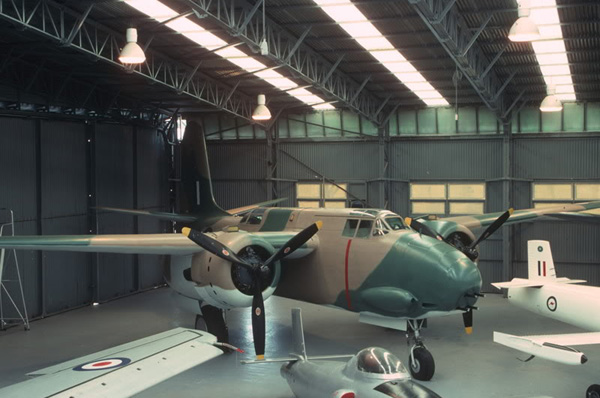 A Boston III on display at the RAAF Museum at Point Cook, Australia. It is the last survivor of the 69 Bostons that served with the RAAF. Almost one year after the French had taken delivery of their DB-7s, A-20A Havocs were delivered to the USAAC/USAAF and were operated by the 3rd Bombardment Group at Savannah Georgia. Additional aircraft were provided for the 27th Bombardment Group. Initially, the engines suffered from overheating and after modifications were made to improve engine cooling, pilots were reporting good results. They performed training exercises in Shreveport, Louisiana in September 1941 and shortly afterwards, the aircraft was officially designated the Havoc. The 58th Bombardment Group received Havocs at Hickman Field, Hawaii but two were destroyed at the raid on Pearl Harbor of December 7, 1941. The first Havocs to perform bombing missions in the Pacific were operated by the 3rd and 89th Bombardment Group and began operations on August 3, 1942 from Port Moresby, New Guinea. They were later joined by the 312th and 417th Bombardment Groups and by September 1944, the Fifth Air Force had a peak inventory of 370 Havocs. By the war’s end, all three groups were operating with A-20Gs. The majority of aircraft were used in low-level missions and some aircraft were equipped with three-cluster bazooka tubes under each wing. The first planes to go into service with the RAF were Havoc Is with the No. 23 Squadron during the winter of 1940-41 in night fighter roles. They were later joined with the No 418 Squadron (RCAF) and the No. 605 Squadron with Boston IIIs. Other squadrons included the No. 25, No. 85 and No. 93. Turbinlite versions of the Havoc I, Havoc II and Boston III were operated by the Nos. 530 to 539 Squadrons. As a light-bomber, it was operated by the No. 88 Squadron in conjunction with Bristol Blenheim IVs. The Nos. 88 and 226 Squadrons were involved in the attempt to stop the "Channel Dash" by the German battlecruisers Scharnhorst and Gneisenau. The German ships made the passage safely because they were able to jam British radar delaying offensive movement by British aircraft.10 In the Western Desert and the Mediterranean, Bostons were flown by RAF Squadrons Nos. 13, 18, 55 and 114 and the Nos. 12 and 24 Squadrons of the South African Air Force (SAAF). They engaged in raids dubbed “Boston Tea Parties” and flew missions in Tunisia, Sicily and Italy. Bostons were replaced with de Havilland Mosquitoes in 1946. The No. 22 Squadron of the Royal Australian Air Force operated 69 DB-7s and A-20s against Japan. They had a variety of different versions of the Havoc from the SAAF and the Netherlands, but to the Australians, they were all known as Bostons. Operations began from Ward’s Strip in Port Moresby on November 5, 1942. The squadron was reequipped with Bristol Beaufighters after suffering their worst loss of 13 Bostons on the ground after a Japanese raid at Morotai on November 23, 1944.
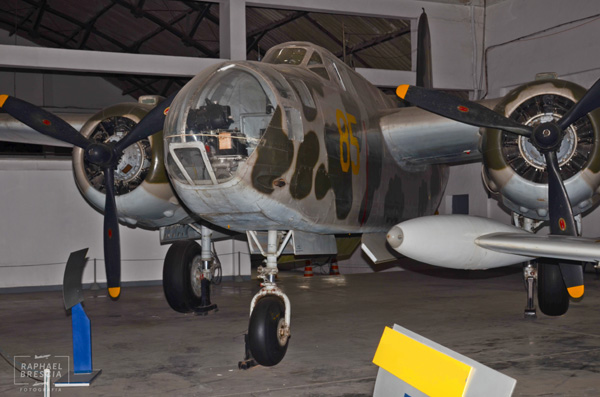 A surviving A-20K Havoc on display at the Museu Aerospespacial in Brazil. The final foreign recipient of the Havoc was the Força Aérea Brasileira, which received 30 SAAF A20G to A-20K Havocs in 1944-45. They saw very little service and one A-20K is on display at the Museu Aerospespacial in Brazil. More than 3,600 havocs were sent to Russia under lend-lease, which was almost twice that sent to the British, and substantially more than the 1,962 aircraft delivered to the USAAF. The majority of the aircraft delivered to the Soviets were A-20s, but records indicate that 20 aircraft were DB-7Bs. Production ended on September 20, 1944 with total of 7,098 Havocs built by Douglas and an additional 380 built by Boeing. By the time of V-E Day, all USAAF A-20 Havocs were replaced with A-26 Invaders and the British Bostons were replaced with de Havilland Mosquitoes. At the end of the war, most Havocs were scrapped and by the early 1960s, only six complete airframes were known to be in existence. Recently, more Havocs have been discovered at crash sites in Russia and the jungles of New Guinea and are undergoing restoration. |
| Specifications: | ||
|---|---|---|
| Dimensions: | ||
| DB-7 Havoc I | A-20G | |
| Wing span: | 61 ft 3 in (18.66 m) | 61 ft 4 in (18.69 m) |
| Length: | 46 ft 11-3/4 in (14.32 m) | 48 ft 0 in (14.63 m) |
| Height: | 15 ft 10 in (4.82 m) | 17 ft 7 in (5.36 m) |
| Weights: | ||
| Empty: | 11,400 lb (5,170 kg) | 15,984 lb (7,250 kg) |
| Takeoff Weight: | 19,040 lb (8,635 kg) | 27,200 lb (12,338 kg) |
| Performance: | ||
| Maximum Speed: | 295 mph (475 km/h) | 317 mph (510 km/h) |
| Service Ceiling: | 25,800 ft (7,865 m) | 25,000 ft (7,620 m) |
| Operating Range: | 996 miles (1,603 km) | 1,025 miles (1,650 km) |
| Powerplant: | ||
|
Two 1,200 hp (895 kW) Pratt & Whitney R-1830-S3C4-G Twin Wasp engines. |
Two 1,600 hp (1,193 kW) Wright R-2600-23 Cyclone engines. |
|
| Armament: | ||
|
Eight 0.30 caliber machine guns. 2,000 lb (900 kg) bombs in an internal bay. | Nine 0.50 caliber machine guns. 4,000 lb (1,800 kg) bombs in an internal bay. | |
Endnotes:
|
1. René J Francillon. McDonnell Douglas Since 1920: Volume I Annapolis, Maryland: Naval Institute Press, 1988. 293. 2. Harry Gann. Aircraft in Profile, Volume 9. Garden City, New York: Doubleday & Company, Inc., 1971. 254-256. 3. E. R. Johnson. Havoc. Aviation History. September 2004. 23. 4. David Mondey. The Concise Guide to American Aircraft of World War II. New York: Smithmark Publishers. 1996. 100. 5. William N. Hess. A-20 Havoc at War. New York: Charles Scribner's Sons, 1979. 11. 6. Enzo Angelucci and Peter Bowers. The American Fighter. Sparkford, England: Haynes Publishing Group, 1987. 185. 7. Terry M. Mays. P-38 Night Fighters in the Solomons. Aviation History. July, 2001. 29. 8. William Green. Famous Bombers of the Second World War. Garden City, New York: Doubleday & Company, Inc., 1975. 142. 9. William N. Hess. A-20 Havoc at War. New York: Charles Scribner's Sons, 1979. 143. 10. Dr. Alfred Price. Instruments of Darkness. London: Greenhill Books, 2005. 77. |
©Larry Dwyer. The Aviation History Online Museum.
All rights reserved.
Created April 29, 2014. Updated August 10, 2014.